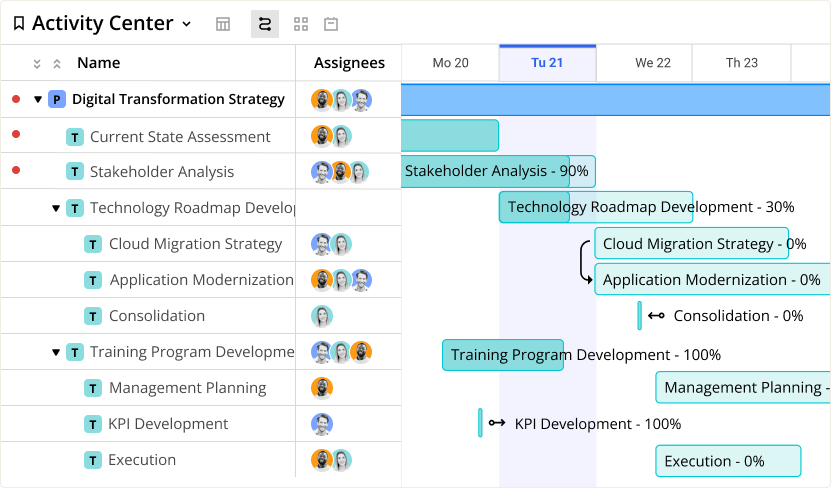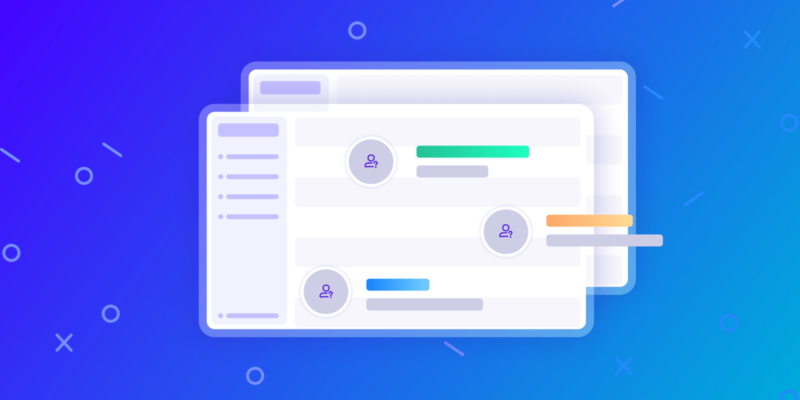In professional services, onboarding and implementation are often used interchangeably, but they are two distinct processes with unique objectives. While both are important for clients, they require different strategies and tools.
Companies that excel at both onboarding and implementation ensure long-term client satisfaction. But how do they differ, and why are both essential?
Let‘s break it down.
What is customer onboarding?
Customer onboarding is the process of building a strong relationship with new clients while guiding them through the setup and adoption of your product. It ensures they can become fully independent users by providing them with the necessary tools, knowledge, and support.
After the initial implementation, onboarding continues with customer education and engagement, ensuring that the client‘s team understands how to use the solution effectively, recognizes its value, and successfully integrates it into their daily workflows.
Key characteristics of onboarding:
- Focuses on training, guidance, and user adoption.
- May continue beyond initial implementation for full adoption.
- Ensures clients achieve measurable success with the product.
Example of onboarding in action:
Using the Project Management Software example, onboarding includes:
- Training sessions for managers and employees.
- Customized tutorials or interactive guides.
- Regular check-ins to ensure clients use key features effectively.
💡 Even with perfect implementation, without proper onboarding, clients may not fully adopt or utilize the product, reducing long-term success.
What is implementation?
Implementation is the technical setup and execution of a product or service for a client. This process focuses on configuring the solution according to client needs, integrating it into their systems, and ensuring that it functions correctly.
Key characteristics of implementation:
- Technical Focus – Involves system setup, integrations, or software configurations.
- Deliverable-Oriented – Completion is based on technical milestones.
- Time-Bound – Has a defined start and end date tied to project scope.
Example of implementation in action:
Imagine a company purchasing a client onboarding software like Birdview PSA.
The implementation phase includes:
- Setting up the software with the client‘s specific requirements.
- Configuring integrations with existing CRM, accounting, or HR tools.
- Migrate data from outdated or incompatible systems.
💡 Without proper implementation, the software may not work as intended, leading to frustration and inefficiencies.
Implementation vs. onboarding: the key differences
In professional services and software deployment, implementation and onboarding are two critical phases that often overlap in discussions but serve distinct purposes. While both are essential for ensuring client success, they focus on different aspects of the customer journey.
Understanding these key differences is crucial to ensuring a smooth transition for clients–from initial setup to full adoption of a product or service. In this chapter, we will break down what sets implementation and onboarding apart, why they both matter, and how they work together to maximize client value.
1. Purpose: execution vs. adoption
At its core, the biggest difference between implementation and onboarding is their primary goal.
- Implementation is focused on the technical execution of setting up, configuring, and delivering a solution. The goal is to ensure that the product or service functions correctly, meets the client’s requirements, and integrates seamlessly into their existing systems.
- Onboarding is about ensuring the client can effectively use the solution after implementation. It involves training, engagement, and support to help clients adopt the product efficiently.
💡 Implementation is defined as building the car and onboarding is teaching the driver how to use it properly.
2. Process focus: technical vs. user-centric
Another key distinction between implementation and onboarding is the focus of the process.
Implementation Focus
Implementation is primarily technical, involving software configuration, system integrations, and data migration. It follows a structured project-based approach with a defined scope, deadlines, and deliverables. Typically led by IT or technical teams, it requires expertise in system architecture and deployment. Implementation has a clear start and end date, concluding once the setup is completed.
Onboarding Focus
Onboarding is centered around user adoption, providing training, support, and education to ensure clients can effectively use the product. It is an ongoing process that can span weeks or months, depending on client needs. Led by customer success teams, onboarding prioritizes client engagement and satisfaction. The timeline is flexible, continuing until the client feels fully confident using the solution.
💡 While implementation is transactional, onboarding is relationship-driven, ensuring that clients are not only set up but also empowered to succeed.
3. Key components of each phase
Implementation Involves:
- System configuration – Customizing the solution to fit the client’s needs.
- Data migration – Transferring information from previous systems.
- Software or hardware setup – Ensuring the infrastructure is functional.
- Integrations – Connecting the solution with third-party tools or internal platforms.
- Testing & troubleshooting – Resolving any technical issues before handover.
Onboarding Includes:
- User training & education – Providing step-by-step guidance on how to use the product.
- Customer support – Offering help through chat, calls, or knowledge bases.
- Process optimization – Advising on best practices for maximum efficiency.
- Adoption tracking – Monitoring engagement levels and product usage.
- Feedback & iteration – Collecting insights to improve future onboarding.
4. The role of each in client success
Both implementation and onboarding play crucial roles in ensuring long-term client success, but they address different challenges.
❗ Without a strong implementation process, clients may face technical difficulties that lead to frustration and early churn.
❗ Without proper onboarding, even a perfectly implemented solution may go unused or underutilized, reducing its value.
For example, if a company implements a CRM system but fails to provide effective onboarding, the sales team may not fully utilize key features, leading to poor adoption rates and missed opportunities.
💡 Similarly, an incomplete or rushed implementation can create problems for onboarding, as users may struggle with a solution that wasn‘t properly set up for their needs.
5. How implementation and onboarding work together
To achieve maximum success, implementation and onboarding must be seamlessly integrated. This begins with early alignment between implementation and customer success teams, ensuring collaboration from the start. Using a centralized platform, such as a Professional Services Automation (PSA) tool like Birdview PSA, helps track both processes in one place, improving visibility and coordination.
A structured transition is essential, allowing onboarding to begin immediately after implementation is complete to ensure smooth adoption. Monitoring client engagement, including training completion rates, product usage, and feedback, helps refine the onboarding process.
💡 By treating implementation and onboarding as complementary phases, businesses can create a seamless client experience that increases retention and drives long-term success.
Why onboarding and implementation work best together
While distinct, onboarding and implementation are interdependent. A seamless implementation ensures a properly configured solution, while onboarding guarantees the client knows how to use it effectively.
How they work together:
- Implementation deploys a CRM system for a sales team.
- Onboarding teaches the sales team how to use the CRM efficiently.
Without implementation, onboarding lacks a solid foundation. Without onboarding, even a perfectly implemented solution might go unused.
💡 To maximize client success, businesses must coordinate both phases and use the right tools to bridge the gap.
How PSA software bridges the gap between onboarding & implementation
A robust PSA platform like Birdview PSA brings implementation and onboarding together in one unified system.
Key benefits:
- End-to-end Project Tracking – Monitor implementation progress and onboarding success.
- Collaboration Tools – Align technical teams and client success managers.
- Real-Time Dashboards – Gain visibility into project milestones, training progress, and user adoption.
- Resource Optimization – Ensure a smooth transition from setup to full adoption.
- Сlient portal – Give clients access to project progress, facilitate collaboration, provide feedback, and accelerate approvals.

💡 By integrating implementation and onboarding into one centralized system, businesses can reduce friction, improve efficiency, and enhance client retention.
Final thoughts: do you need both?
❗ Yes–both implementation and onboarding are essential for delivering maximum value to clients.
Companies that prioritize both enjoy higher client retention, better user adoption, and increased satisfaction–ultimately driving business growth and profitability.
By leveraging the right tools and strategies, businesses can create a structured, efficient approach to implementation and onboarding–ensuring clients not only receive a solution but also know how to use it for success.
Do you need both onboarding and implementation?
Yes!
Implementation ensures a successful setup.
Onboarding ensures successful adoption.
Companies that invest in both deliver higher client satisfaction, faster adoption rates, and long-term retention.
Gain full visibility, control, and confidence
with Birdview PSA
or
You may be interested in…
What is Professional Services Automation (PSA)?
20+ client onboarding best practices, checklist, & strategies
Client Project Management: Best Practices
Client Onboarding Automation: Strategy and Benefits
Best Customer Success Software



